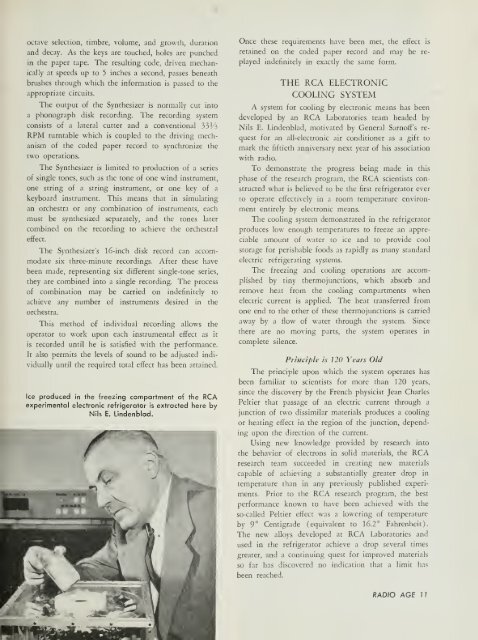Radio Age - 1955, April - 36 Pages, 2.8 MB, .PDF - VacuumTubeEra
Radio Age - 1955, April - 36 Pages, 2.8 MB, .PDF - VacuumTubeEra
Radio Age - 1955, April - 36 Pages, 2.8 MB, .PDF - VacuumTubeEra
You also want an ePaper? Increase the reach of your titles
YUMPU automatically turns print PDFs into web optimized ePapers that Google loves.
octave selection, timbre, volume, and growth, duration<br />
and decay. As the keys are touched, holes are punched<br />
in the paper tape. The resulting code, driven mechanically<br />
at speeds up to 5 inches a second, passes beneath<br />
brushes through which the information is passed to the<br />
appropriate circuits.<br />
The output of the Synthesizer is normally cut into<br />
a phonograph disk recording. The recording system<br />
consists of a lateral cutter and a conventional 33J/3<br />
RPM turntable which is coupled to the driving mechanism<br />
of the coded paper record to synchronize the<br />
two operations.<br />
The Synthesizer is limited to production of a series<br />
of single tones, such as the tone of one wind instrument,<br />
one string of a string instrument, or one key of a<br />
keyboard instrument. This means that in simulating<br />
an orchestra or any combination of instruments, each<br />
must be synthesized separately, and the tones later<br />
combined on the recording to achieve the orchestral<br />
effect.<br />
The Synthesizer's 16-inch disk record can accommodate<br />
six three-minute recordings. After these have<br />
been made, representing six different single-tone series,<br />
they are combined into a single recording. The process<br />
of combination may be carried on indefinitely to<br />
achieve any number of instruments desired in the<br />
orchestra.<br />
This method of individual recording allows the<br />
operator to work upon each instrumental effect as it<br />
is recorded until he is satisfied with the performance.<br />
It also permits the levels of sound to be adjusted individually<br />
until the required total effect has been attained.<br />
Ice produced in the freezing compartment of the RCA<br />
experimental electronic refrigerator is extracted here by<br />
Nils E. Lindenblad.<br />
Once these requirements have been met, the effect is<br />
retained on the coded paper record and may be replayed<br />
indefinitely in exactly the same form.<br />
THE RCA ELECTRONIC<br />
COOLING SYSTEM<br />
A system for cooling by electronic means has been<br />
developed by an RCA Laboratories team headed by<br />
Nils E. Lindenblad, motivated by General Sarnoff's request<br />
for an all-electronic air conditioner as a gift to<br />
mark the fiftieth anniversary next year of his association<br />
with radio.<br />
To demonstrate the progress being made in this<br />
phase of the research program, the RCA scientists constructed<br />
what is believed to be the first refrigerator ever<br />
to operate effectively in a room temperature environment<br />
entirely by electronic means.<br />
The cooling system demonstrated in the refrigerator<br />
produces low enough temperatures to freeze an appreciable<br />
amount of water to ice and to provide cool<br />
storage for perishable foods as rapidly as many standard<br />
electric refrigerating systems.<br />
The freezing and cooling operations are accomplished<br />
by tiny thermojunctions, which absorb and<br />
remove heat from the cooling compartments when<br />
electric current is applied. The heat transferred from<br />
one end to the other of these thermojunctions is carried<br />
away by a flow of water through the system. Since<br />
there are no moving parts, the system operates in<br />
complete silence.<br />
Principle is 120 Years Old<br />
The principle upon which the system operates has<br />
been familiar to scientists for more than 120 years,<br />
since the discovery by the French physicist Jean Charles<br />
Peltier that passage of an electric current through a<br />
junction of two dissimilar materials produces a cooling<br />
or heating effect in the region of the junction, depending<br />
upon the direction of the current.<br />
Using new knowledge provided by research into<br />
the behavior of electrons in solid materials, the RCA<br />
research team succeeded in creating new materials<br />
capable of achieving a substantially greater drop in<br />
temperature than in any previously published experiments.<br />
Prior to the RCA research program, the best<br />
performance known to have been achieved with the<br />
so-called Peltier effect was a lowering of temperature<br />
by 9° Centigrade (equivalent to 16.2° Fahrenheit).<br />
The new alloys developed at RCA Laboratories and<br />
used in the refrigerator achieve a drop several times<br />
greater, and a continuing quest for improved materials<br />
so far has discovered no indication that a limit has<br />
been reached.<br />
min ii<br />
in i Hi<br />
RADIO AGE n
















